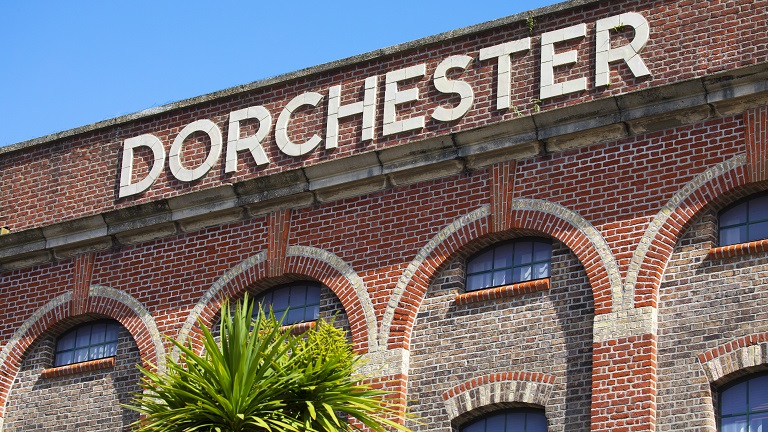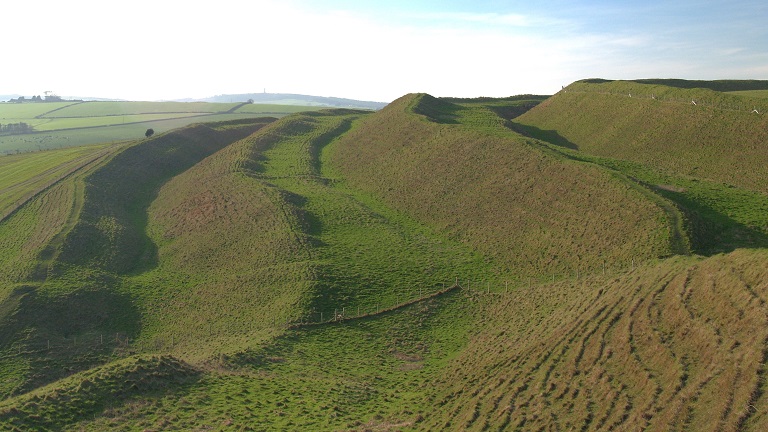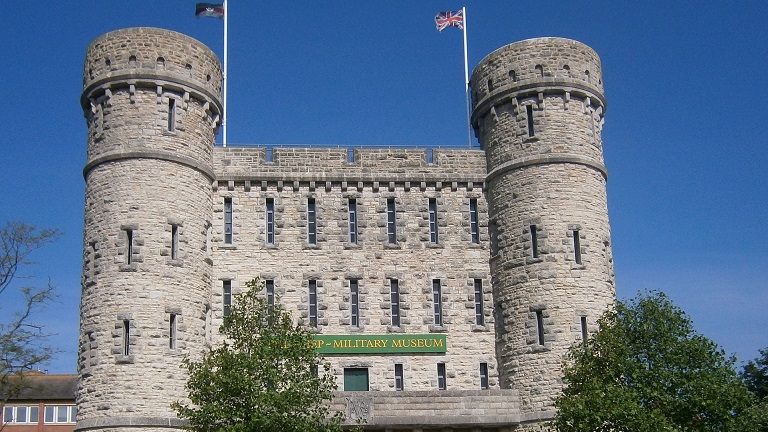Perhaps it’s the footsteps of Romans you seek, or the mighty bones of fossilized giants. Maybe it’s the words of Thomas Hardy that sweep you away, or rather it’s the whisper of adventure that beckons you. It might be the promise of fine fare that whets your appetite, or it could be the allure of simply doing nothing at all that inspires a holiday in Dorchester. Whatever your calling, you’ll find everything you could need and more for an unforgettable break in this delightful countryside town.
History

Human activity in Dorchester dates back to the Iron Age. In fact, there was once a great Iron Age hillfort just 2 miles from the town that is believed to have been one of the most powerful settlements in pre-Roman Britain. Officially founded as a town in AD70 when the Romans ousted the local Durotriges tribe, Dorchester (or Durnovaria as it was known back then) spent the next several hundred years growing in size and strength and by the 4th Century, was an important market centre. Even today, the remains of the Roman walls that once protected the town can still be seen near the ‘Top 'o Town’.
After the Romans, the Dumnonii (British Celts), Vikings, Anglo-Saxons and the Normans all had their go at taking over the town, with its name evolving from Durnovaria to Dornwaracester to Dorchester over the centuries. Unfortunately, in the 17th and 18th Centuries, the town was ravaged by a series of fires (caused by everything from a blazing cauldron to a flaming soap boiler) which destroyed the majority of Dorchester’s older buildings. Even so, a handful still remain and today the town exudes history at every turn. From ancient sites to public museums to recited verse, the town’s history is preserved and shared in numerous ways.

Bloody Assizes
During the late 1600s, the Monmouth Rebellion was launched by James Scott, the Duke of Monmouth and illegitimate son of King Charles II, in an attempt to overthrow King James II. Ultimately ending in failure, the coup culminated in the unsuccessful Battle of Sedgemoor in 1685, after which the Duke and hundreds of his supporters were captured. While many rebels were killed upon discovery, many others were imprisoned ahead of a series of trials known as the Bloody Assizes. Infamously, some of these trials, led by the merciless Judge Jeffreys, were held in Dorchester in the Oak Room of the Antelope Hotel on Cornhill, during which dozens of men were sentenced to death.
The Tolpuddle Martyrs
In 1833, six agricultural labourers from Tolpuddle, a village just a few miles from Dorchester, were arrested for what was essentially peacefully protesting against low wages. In 1834, they were tried in Dorchester’s Shire Hall and sentenced to deportation to Australia. Far from ‘out of sight out of mind’ though, the men’s deportation spurred on mass protest from the British public – so much so that a petition was signed by more than 800,000 people and mass peaceful marches were organised in support of their return. Eventually, the men were pardoned, and the events became an important cornerstone for early union and workers' rights movements. Today, you can visit the Tolpuddle Martyrs Museum in Dorchester to learn more.
Thomas Hardy
One of the town’s most famous figures, Thomas Hardy was a world-renowned author and poet who wrote many famous poems and novels including Tess of the D´Urbervilles, Far From the Madding Crowd, The Mayor of Casterbridge and The Woodlanders. He was born in June 1840 in a cottage near Dorchester and spent much of his life travelling between Dorset and London, before eventually settling back in Dorchester permanently. During his time in the county, he spent much time with his friend T.E. Lawrence (aka Lawrence of Arabia) and used his beloved landscapes as the inspiration and setting for many of his works. Today, you can visit his homes and explore Thomas Hardy Country along the Hardy Way walking trail.
Shopping
.jpg)
From its local markets to glass-fronted shops to antique centres, Dorchester is a fabulous place for shopping. Its high street is home to a collection of many household favourites, alongside independent shops and boutiques. Particularly popular, Brewery Square is a popular destination for shoppers and foodies, having been converted in 2012 into a contemporary complex with shops, restaurants and a cinema. If you are in Dorchester on a Wednesday, you can visit the Town Market which is held opposite Brewery Square and find everything from local fruit and vegetables, freshly-baked bread, quality meats, plants and more. Overlooking the famous Maiden Castle, Dorchester’s monthly farmers’ market takes place in Queen Mother’s Square in Poundbury on the first Saturday of the month and is also great for sampling local produce.
Places to Eat and Drink
Follow your nose around Dorchester and you will discover a wealth of superb eateries in the form of cosy pubs, quaint tearooms and modern bistros. Whether it’s a light bite or the full shebang you’re after, you will find food inspired by every corner of the globe to tease your tastebuds with, along with traditional Dorset favourites. Of course, many of these eateries use ingredients sourced from the county’s abundance of producers, growers, bakers and more, showcasing the very best of land and sea. There are also some great markets and delis, including the Fridge deli, which are great for picking up local goodies for feasts at home. Yalbury Cottage, Taste Brasserie, The Georgie Porgie Pie & Burger Co and Myra's Kaiseki are all particularly recommended eateries.
Attractions
Museums

From teddy bears to military history, Dorchester's museums promise fascinating hours of discovery whatever the weather. Perhaps the most well-known is the Dorset County Museum, which celebrates 250 million years of Dorset history. Among its many exhibits, it showcases everything from Celtic and Roman artefacts from Maiden Castle and Roman Dorchester to original manuscripts and personal items belonging to Thomas Hardy. You can also visit the Keep Military Museum, the Teddy Bear Museum, the Tutankhamun Exhibition and the Terracotta Warriors Museum. For dinosaur fans, the Dinosaur Museum offers a rawrfully good time with all sorts of dino fossils found along the nearby Jurassic Coast. Meanwhile, the Shire Hall and Courthouse Museum is a real point of interest, being both the site of the Tolpuddle Martyrs trial and the domestic abuse case which inspired Hardy’s Tess of the D’Urbervilles.
Ancient Sites
With thousands of years of history under its grassy belt, Dorchester and its surrounding landscapes are etched with the evidence of bygone civilisations. One of the most famous Neolithic sites in the UK, Maiden Castle lies just south of Dorchester and was once an important Iron Age hillfort and settlement some 4,000 years ago. Built in the same millennium, the nearby Maumbury Rings are also worth a visit. Though the exact purpose of the site’s creation is unknown, the space was repurposed by the Romans who turned it into a public amphitheatre, and this is very much apparent today in the size and shape of its remains. Nestled within the grounds of County Hall is Dorchester Roman Town House, another fascinating ancient site in Dorchester. Free to visit, these are the remains of the only fully-exposed Roman Town House in the country.
Hardy’s Cottages
In the heart of Thomas Hardy Country, Dorchester is known for being the home of one of the UK’s most famous Victorian writers and poets. Should you find yourself following his literary journey, you should definitely put some time aside to visit two of the buildings most closely associated with him. The first, known as Hardy’s Cottage, is in Higher Brockhampton, just a 10-minute drive from Dorchester. A picturesque, thatched cottage framed by creepers and wildflowers, this is where Thomas was born in 1840 and later wrote many of his early short stories. The second building you can visit is Max Gate, which is located on the outskirts of Dorchester. Now looked after by the National Trust, this house was designed by Hardy himself (who was also an architect) and was where he lived until his death in 1928.
Things to Do
Walk the River Frome

A great way to discover Dorchester and its enveloping countryside is by following the line of the River Frome (pronounced “froom”). Traced by the 18-mile Frome Valley Walkway, you can easily wend your way along the riverbanks, enjoying the wealth of different landscapes and scenes that slip past your shoulders as you go. And, as this route follows a set course, you don’t have to worry about going off-piste and can choose exactly how far you want to walk before turning around again.
Picnic in Borough Gardens
First opened in 1896, Dorchester’s Borough Gardens were designed by the famous landscape architect and naturalist William Goldring (once the President of the Kew Guild, The Royal Botanic Gardens). Providing a tranquil space for all generations, the gardens combine a mixture of planted areas, parkland and recreational space and are perfect for a leisurely picnic under sunny skies. Among the facilities available, the gardens include a children’s playpark, outdoor fitness equipment, refreshment kiosks, toilets and more. It’s also a centre for many local events and festivities that take place throughout the year.
Hike the Hardy Way
If you have a taste for adventure or lust for literary exploration, then taking a hike along the Hardy Way will tick all the boxes. While smaller sections of the route can be completed in just a few hours, the whole length of this long-distance trail covers a whopping 217 miles. So, we don’t recommend trying it in a day. Running through Thomas Hardy’s Wessex, this gigantic circular loop wends through Dorchester and beyond to include stunning sections of Dorset countryside and Jurassic Coast. Highlights include the Frome Valley, Corfe Castle, Lulworth Cove and, of course, Dorchester. Read more about it here.
Feeling inspired? Look at more things to do in Dorchester or take a peek at our luxury cottages in Dorset.
.jpg)